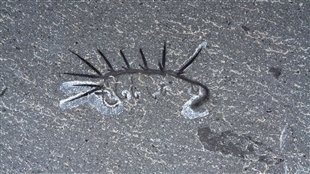A famous and bizarre marine animal from 505 million years ago called Hallucigenia sparsa turns out to have had relatives the world over, according to joint Canadian and British research. A fossil from the famous Burgess Shale site in the Rocky Mountains of western Canada indicates the creature was a spiny, worm-like animal with numerous pairs of soft legs, about the size of a fingernail.

© Jean-Bernard Caron/Royal Ontario Museum
Fossils from this area are unique in that the soft body parts were preserved as well as the hard ones. It’s thought that creatures at the bottom of the Cambrian sea were buried very quickly and covered in a way that preserved them from predators and decay. The rocks much later heaved up to form the mountain range.
Ice cream cone spines
Just the spines have been found in other parts of the world and it is only recently that researchers from the Royal Ontario Museum and the Universities of Toronto and Cambridge have used new techniques to match them to the spines of Hallucigenia sparsa. Both animals’ spines have subtle surface ornamentation and a structure described as resembling a stack of ice cream cones.
Spines have been found in many parts of the world ranging from Canada, the United States, China, Mongolia, the United Kingdom and Australia. The evidence is enough to suggest Hallucigenia formed a group of animals that spanned the planet’s Cambrian seafloors.
Find “very surprising”
“It was very surprising,” said Jean-Bernard Caron, curator of paleontology at the Royal Ontario Museum in Toronto. “It really helps us to better understand the family tree of this weird animal.”

well as hard. © John Niddrie/Parks Canada
This creature relates to the modern day velvet worm which lives in fallen logs in jungles throughout the world. Although they lived in different environments both appear to be micropredators or scavengers and they probably played similar ecological roles.
Burgess Shale a World Heritage site
The Burgess Shale was recognized in 1981 as one of the first UNESCO World Heritages Sites to be declared in Canada. It is now managed by the government department, Parks Canada as it is situated in Yoho National Park in the province of British Columbia.
Parks Canada runs guided hikes to fossil sites and has the responsibility to protect the fossils. Special permits are required for digging.







For reasons beyond our control, and for an undetermined period of time, our comment section is now closed. However, our social networks remain open to your contributions.